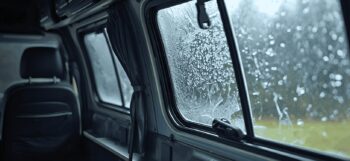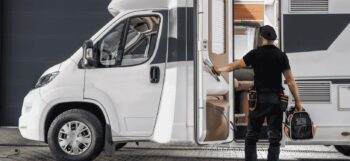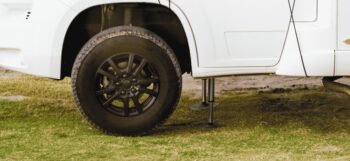Checking the noseweight of your caravan is a key part of safe towing. If it's too high or low, it can affect handling, stability, and braking performance. That’s why taking a few minutes to measure and adjust the noseweight can make all the difference before you set off.
In this guide, we’ll explain what noseweight is, how to measure it, and how to make adjustments so you can get going on your next adventure safely.
What is a caravan’s noseweight?
A caravan’s noseweight is the amount of downward pressure the front of the caravan puts on the tow ball of your car. It’s measured in kilograms and helps to keep the caravan stable when you're towing it.
Maintaining the correct noseweight is essential for safe towing. Too much weight on the tow ball can affect steering and put excessive strain on your vehicle’s rear suspension. Too little can make your caravan unstable, which can lead to swaying or poor road handling, especially at higher speeds.
The aim is to achieve a balanced load that keeps your caravan steady and under control while you're on the road.

Where to find your caravan’s noseweight limit
Before you measure or adjust the noseweight, you’ll should know the maximum limit for your caravan. You can usually find this in the owner’s manual, on a data plate near the hitch, or in the manufacturer’s manual.
As a general guide, a stable noseweight is typically 5–7% of your caravan’s fully loaded weight. But don’t rely on estimates alone. Always check the lowest limit given for your caravan, tow bar, and tow ball, and make sure you stay within that number. To stay safe, check your limits before every trip.
If you exceed the noseweight limit, you could:
- Wear out your tyres or suspension more quickly.
- Lose grip between the tow vehicle and the road.
- Struggle with steering or braking.
- Increase the risk of instability when towing.
How to measure a caravan's noseweight
Measuring your caravan’s noseweight is a simple process. You can use either a noseweight gauge or a set of household bathroom scales with a few supporting materials.
Before you begin, make sure you know:
- Your caravan’s noseweight limit.
- The maximum noseweight for your tow bar.
- The limit for your vehicle’s tow ball.
Use the lowest of these figures as your maximum noseweight.
Option 1: Using a noseweight gauge
- Park your caravan on a level surface and apply the handbrake.
- Load the caravan as you would for travel.
- Place the gauge under the coupling head (found at the front of the A-frame).
- Wind down the jockey wheel until the hitch head is just above the gauge.
- Carefully lower the hitch onto the gauge and take a reading.
- Compare the result with your allowed noseweight limit.
Option 2: Using bathroom scales and a broom handle
- Place a sturdy piece of wood or metal (like a broom handle) vertically between the hitch head and the scales.
- Protect the scales and hitch with wood blocks or padding to spread the load.
- Position the scales on a firm, level surface.
- Slowly lower the coupling head onto the handle until it’s fully supported.
- Read the weight displayed on the scales.
- Check that it falls within your safe limit.
If the reading is too high or too low, you’ll need to adjust the weight distribution inside the caravan.

How to adjust your caravan’s noseweight
If your noseweight is too high or too low, you can usually fix it by adjusting how your caravan is loaded. The goal is to keep the noseweight within the safe limit set by your caravan manufacturer, tow bar, or tow ball, whichever is lowest.
Here are some simple ways to adjust it:
- Move heavy items behind the axle: If the noseweight is too high, try moving heavier items further back, behind the caravan’s axle line. This helps take some of the weight off the front.
- Relocate lighter items to the front: If the noseweight is too low, place lighter items towards the front of the caravan, ahead of the axle.
- Move items into the towing vehicle: Store non-essential items or heavier equipment in your car if space allows. This can reduce the overall weight inside the caravan and help you balance the load.
- Leave out unnecessary items: If you're still over the limit, consider whether what you’ve packed is essential for the trip.
Always recheck the noseweight after making changes. Even small adjustments can have a noticeable impact on balance and stability.
Note: Never exceed the stated noseweight limit. Doing so can affect the stability of your caravan, which could pose a safety risk while towing it.

How often should you check the noseweight of a caravan?
Checking noseweight is a quick and essential part of pre-travel safety checks. After all, it helps your caravan is stay suitable and loaded correctly so you stay legal on the road.
You should check your caravan’s noseweight before every journey. Even if you haven’t changed much since your last trip, small differences can still affect your caravan’s load.
Protecting your touring caravan on your adventures
Taking care of your caravan’s noseweight is just one part of staying safe while towing. Touring caravans face a range of risks while being towed, stored, or used on site, so having insurance can help to offer valuable protection against unexpected costs.
At Lifesure, our touring caravan insurance is designed to help protect your caravan and belongings, whether you're on the move or parked up at a campsite. You can also add RAC touring caravan breakdown insurance for more protection during your travels.
Fill in our online form to get an instant quote or call us on 01480 402 460 and one of our advisors can help.
Disclaimer: The sole purpose of this article is to provide guidance on the issues covered. This article is not intended to give legal advice, and, accordingly, it should not be relied upon. It should not be regarded as a comprehensive statement of the law and/or market practice in this area. We make no claims as to the completeness or accuracy of the information contained herein or in the links which were live at the date of publication. You should not act upon (or should refrain from acting upon) information in this publication without first seeking specific legal and/or specialist advice. Arthur J. Gallagher Insurance Brokers Limited trading as Lifesure accepts no liability for any inaccuracy, omission or mistake in this publication, nor will we be responsible for any loss which may be suffered as a result of any person relying on the information contained herein.
FP711-2025











